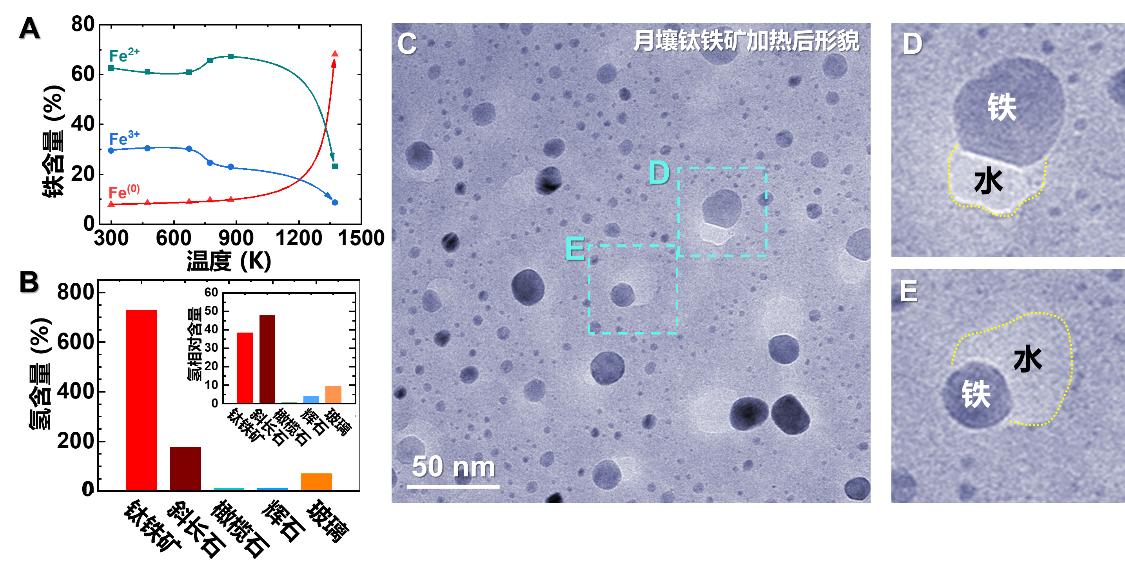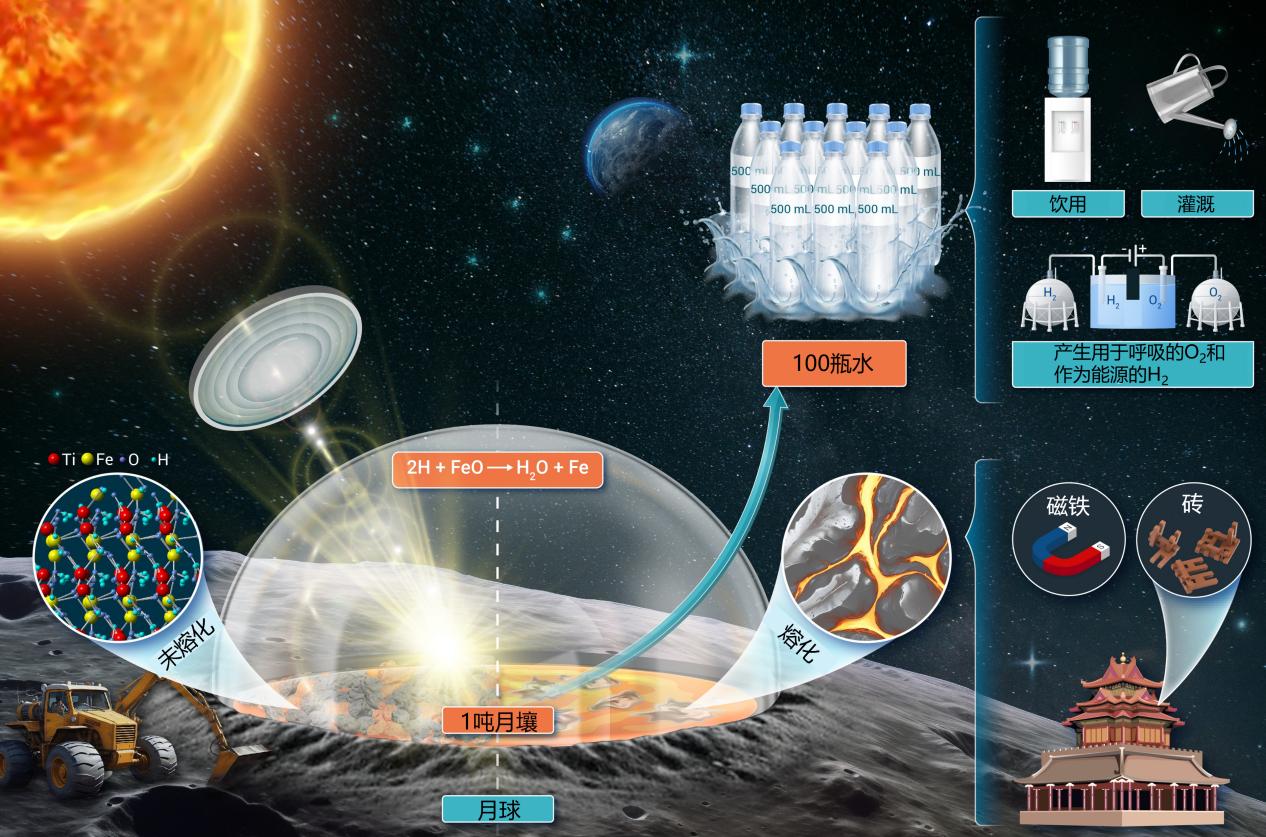

Scientists remove lunar regolith samples from the Chang'e 5 lunar mission inside a glove box. From left to right: Associate Researcher Xu Wei, PhD student Chen Xiao, Researcher Wang Junqiang, Researcher Huo Juntao, and Dr. Chen Guoxin.
Chinese scientists have proposed a novel method for extracting large quantities of water on the Moon, which is expected to provide important design foundations for future lunar research stations and space station construction.
On August 22nd, Beijing time, the related paper was published online in the international academic journal "The Innovation." The paper is titled "Massive Water Production from Lunar Ilmenite through Reaction with Endogenous Hydrogen."
This research was conducted by the Amorphous Alloy Magnetic and Electric Functional Properties Research Team at the Ningbo Institute of Materials Technology and Engineering, Chinese Academy of Sciences (hereinafter referred to as "Ningbo Materials Institute"), in collaboration with the Institute of Physics of the Chinese Academy of Sciences (hereinafter referred to as "Institute of Physics"), the Qian Xuesen Laboratory of the Fifth Academy of Aerospace, Songshan Lake Materials Laboratory, Harbin Institute of Technology, and Nanjing University, among other research teams.
The aforementioned paper presents a groundbreaking method for producing water based on high-temperature redox reactions by studying the hydrogen content in various minerals of Chang'e 5 lunar regolith.
Through analyses utilizing advanced experimental techniques like high-resolution electron microscopy and electron energy loss spectroscopy, the research team confirmed that approximately 51-76 milligrams of water can be produced from 1 gram of lunar regolith (equivalent to 5.1%-7.6% water content).
Based on these calculations, 1 ton of lunar regolith could yield about 51-76 kilograms of water, equivalent to over 100 bottles of 500 milliliters each, which would essentially meet the daily drinking needs of 50 people.

Lunar regolith stored in experimental bottles.
Water is a critical resource for establishing lunar research stations and facilitating future interstellar travel on the Moon, ensuring human survival.
After three years of in-depth research and repeated validation, the scientists discovered that lunar minerals, due to the solar wind's irradiation over billions of years, store substantial amounts of hydrogen. When heated to high temperatures, the hydrogen reacts with iron oxides in the minerals, producing elemental iron and significant amounts of water.
When heated above 1000℃, the lunar regolith melts, and the water generated from the reaction is released as water vapor.
Computational simulations show that there are nanoscale microchannels in the titanium iron ore found in lunar regolith, which can adsorb and store large quantities of hydrogen atoms from the solar wind. Each ilmenite molecule (FeTiO3) can adsorb four hydrogen atoms, making it a veritable "reservoir" of water on the Moon.
The researchers also found that electron irradiation can lower the reaction temperature between hydrogen and iron oxides, allowing water production temperatures to be reduced from 600℃ to 200℃.

The formation process of water and elemental iron during the heating of lunar regolith and a comparison of the water content of various major minerals. A. Changes in the valence state of iron in lunar regolith during heating; B. A comparison of hydrogen content in major minerals of lunar regolith, with the insert illustrating the weighted overall hydrogen content based on mineral abundance; C. Transmission electron microscopy image of lunar ilmenite after heating; D and E are magnified images of water vapor bubbles and elemental iron generated during the heating of lunar ilmenite, both showing a symbiotic relationship.
Based on the findings, the research team has proposed a feasible strategy for in-situ resource extraction and utilization of lunar water: (1) First, focus sunlight using a concave mirror or Fresnel lens to heat the lunar regolith until it melts. During this heating process, the lunar regolith will react with hydrogen injected from the solar wind to produce water, elemental iron, and ceramic glass. (2) The generated water vapor is condensed into liquid water and stored in tanks, meeting the drinking needs of humans and various plants and animals on the Moon. (3) Water can be electrolyzed to produce oxygen and hydrogen; the oxygen can be used for human respiration, while the hydrogen serves as an energy source. (4) Iron can be used to manufacture permanent magnets and soft magnetic materials, providing raw materials for electrical electronic devices, and can also serve as building materials. (5) The molten lunar regolith can be made into interlocking bricks for constructing lunar base buildings. This strategy will provide critical design foundations for the future construction of lunar research stations and space stations, with plans to launch verification equipment in subsequent Chang'e lunar exploration missions for further confirmation.

Illustration: The in-situ extraction and utilization strategy for collecting lunar water by heating lunar regolith.
Researchers Huo Juntao and Wang Junqiang from Ningbo Materials Institute, along with Bai Haiyang from the Institute of Physics, are the corresponding authors of the paper. PhD students Chen Xiao and Yang Shiyu, Dr. Chen Guoxin, and Associate Researcher Xu Wei from Ningbo Materials Institute are co-first authors. Ningbo Materials Institute is the leading and first correspondence unit for this research.
Paper link: https://www.cell.com/the-innovation/fulltext/S2666-6758(24)00128-0


